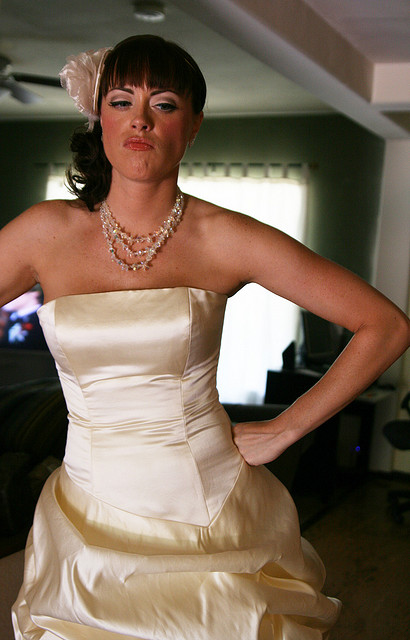Archive for the ‘Feelings’ Category
A Healthy Dissatisfaction With Success
 They say job satisfaction is important for productivity and quality. The thinking goes something like this: A happy worker is a productive one, and a satisfied worker does good work. This may be true, but it’s not always the best way.
They say job satisfaction is important for productivity and quality. The thinking goes something like this: A happy worker is a productive one, and a satisfied worker does good work. This may be true, but it’s not always the best way.
I think we may be better served by a therapeutic dose of job dissatisfaction. Though there are many strains of job satisfaction, the most beneficial one spawns from a healthy dissatisfaction with our success. The tell-tale symptom of dissatisfaction is loneliness, and the invasive bacterium is misunderstanding. When the disease is progressing well, people feel lonely because they’re misunderstood.
Recycled ideas are well understood; company dogma is well understood; ideas that have created success are well understood. In order to be misunderstood, there must be new ideas, ideas that are different. Different ideas don’t fit existing diagnoses and create misunderstanding which festers into loneliness. In contrast, when groupthink is the disease there is no loneliness because there are no new ideas.
For those that believe last year’s ideas are good enough, different ideas are not to be celebrated. But for those that believe otherwise, new ideas are vital, different is to be celebrated, and loneliness is an important precursor to innovation.
Yes, new ideas can grow misunderstanding, but misunderstanding on its own cannot grow loneliness. Loneliness is fueled by caring, and without it the helpful strain of loneliness cannot grow. Caring for a better future, caring for company longevity, caring for a better way – each can create the conditions for loneliness to grow.
When loneliness is the symptom, the prognosis is good. The loneliness means the organization has new ideas; it means the ideas are so good people are willing to endure personal suffering to make them a reality; and, most importantly, it means people care deeply about the company and its long term success.
I urge you to keep your eye out for the markers that define the helpful strain of loneliness. And when you spot it, I hope you will care enough to dig in a little. I urge you think of this loneliness as the genes of a potentially game-changing idea. When ideas are powerful enough to grow loneliness, they’re powerful enough to move from evolutionary into revolutionary.
Hearts Before Minds
 We often forget, but regardless of industry, technology, product, or service, it’s a battle for hearts and minds.
We often forget, but regardless of industry, technology, product, or service, it’s a battle for hearts and minds.
The building blocks of business are processes, machines, software, and computers, but people are the underpinning. The building blocks respond in a repeatable way – same input, same output – and without judgment. People, however, not so much.
People respond differently depending on delivery – even small nuances can alter the response, and when hot buttons are pushed responses can be highly nonlinear. One day to the next, people’s responses to similar input can be markedly different. Yet we forget people are not like software or machines, and we go about our work with expectations people will respond with highly rational, highly linear, A-then-B logic. But in a battle between rational and emotional, it’s emotional by a landslide.
Thankfully, we’re not just cogs in the machine. But for the machine to run, it’s imperative to win the hearts and minds. (I feel a little silly writing this because it’s so fundamental, but it needs to be written.) And it’s hearts then minds. The heart is won by emotion, and once the emotional connection is made, the heart tells the mind to look at the situation and construct logic to fit. The heart clears the path so the mind can in good conscience come along for the ride.
Hearts are best won face-to-face, but, unfortunately today’s default mode is PowerPoint-to-face. We don’t have to like it, but it’s here to stay. And so, we must learn to win hearts, to make an emotional connection, to tell stories with PowerPoint.
To tell a story with PowerPoint, we must bring ourselves to the forefront and send PowerPoint to the back. To prevent ourselves from hiding behind our slides, take the words off and replace them with a single, large image – instead of a complex word-stuffed jumble, think framed artwork. While their faces look at the picture, tell their hearts a story. Eliminate words from the slides and the story emerges.
[There’s still a place for words, but limit yourself to three words per slide, and make them big – 60 point font. And keep it under ten slides. More than that and you haven’t distilled the story in your head.]
Whatever business you’re in, you’re in the people business. Win hearts and minds follow. And so do profits.
Do You Care Enough To Be Lonely?
 If you don’t feel lonely, you’ve succumbed to group-think. No, it’s worse – you’ve stopped thinking altogether. If you don’t feel lonely you’re doing it wrong.
If you don’t feel lonely, you’ve succumbed to group-think. No, it’s worse – you’ve stopped thinking altogether. If you don’t feel lonely you’re doing it wrong.
Mainstream follows mainstream – they don’t know why, they just do. In truth, mainstream likes to be lead by the nose because it’s easy, because they can get through the week without caring. But not caring is not right.
But when you care, when you really care, when you care so much it hurts, you’ve got it right. Loneliness hurts because you see habitual mistakes on the horizon; it hurts because you see bureaucracy trump thinking; it hurts because you see hierarchy squelch creativity. Put simply – it hurts because you care enough to look and you’re smart enough to see.
But take comfort in your loneliness. Though sometimes it feels they want to poke your eyes out, deep down companies want you to see. Sure, they’re afraid of the ruckus, but they want you to wrestle with the familiar. Yes, they won’t sanction your detectiveness, but they want you to investigate the crime scene. Absolutely – though with plausible deniability – they want your inner Nostradamus to conger the future.
Every-day-all-day loneliness is too much, but a low dose is good. 100% loneliness festers into anger, but now-and-again loneliness is healthy.
Take stock in your loneliness – it’s a sign your brain is turned on. And it’s a sign you care.
Why Tough Choices Are Tough
 This week my son made a difficult choice – he chose between two things he loves.
This week my son made a difficult choice – he chose between two things he loves.
The easy choice was to say yes to both, but in reality, there was not enough time. And in reality, the easy yes was a masquerade. It was really a slow, painful no with rippling consequences to his future. The tough choice did not come immediately and it did not come easy. But in the end, he was ready to make it because he saw things not as he wanted them to be, but as they were.
Once he decided he was going to choose, he had to decide which to choose. A tough choice made tougher because one is mainstream and the other on the fringe. It was clear there were far more overt repercussions with a no to the mainstream. Simply put, the powerful mainstream would not understand. But to his credit, he recognized the mainstream cares about itself, not him. Also, it was clear the fringe accepts him for him. So he sat himself in the future, figured out what was best for the soon-to-be him, and chose the fringe.
Once he decided which to chose, he had to decide how to choose. The easy choice was to slink quietly into the fringe never to be seen again. This was another masquerade. It was really an opportunity to self-devalue his decision and a setup for never ending ridicule over the remainder of his high school career. Instead, he made the tough choice to speak truth to the mainstream authority – face-to-face.
He got up early and met the coach in his office. The gist of the meeting – I’m sad, but this is my choice and why I’m choosing.
To the coach’s great credit, though disappointed, he understood and thanked Ethan for meeting face-to-face. And though emotionally wobbly after the meeting, because he declared his choice and was validated, he stood taller. And once validated by the head of the mainstream, there was no room for ridicule.
This week my son showed me what courage is. And he taught me an important lesson – tough decisions are tough, but we’re better off for making them.
I’m proud of him.
Not Invented Here
 Not Invented Here (NIH) is ever-present and misunderstood.
Not Invented Here (NIH) is ever-present and misunderstood.
An operational definition of NIH: Group 1 creates new thinking that falls within the official domain of Group 2. When presented with the new thinking, Group 2 rejects it.
It is said Group 2 rejects new thinking because they’re threatened. But that’s too high level to be helpful. To get at the root of it, we need to dig.
First, some NIH:
- Your new thinking is out of alignment with my priorities. Even if I spend a lot of time to understand it, I’m afraid I’ll fail. I reject your new thinking.
- Your new thinking is out of alignment with responsibility. (That thinking should come from me.) If I adopt your new thinking, I’ll look stupid, and I’m afraid I’ll fail. I reject your new thinking.
- Your new thinking is out of alignment with my knowledge. I’m afraid I’ll fail. I reject your new thinking.
- Your new thinking is out of alignment with how I do things. I’m afraid I’ll fail. I reject your new thinking.
Now, some non-NIH :
- My priorities are out of alignment with your new thinking. Though I already have several good ideas that I don’t have time for, can you give me more details so together we can combine the best elements?
- My responsibility is out of alignment with your new thinking, but your new thinking is good. Can you give me more details so together we can investigate possibilities?
- My knowledge is out of alignment with your new thinking. Can you give me more details so we can learn together?
- My way of doing things is out of alignment with your new thinking. Can you give me more details so together we can rethink things?
The key to NIH reduction is to create alignment. With your new thinking not yet fully formed, ask Group 2 for their input. Better yet, ask for their help. Tell them what you don’t know, tell them what you have wrong, tell them how they have a better perspective because it’s their domain, and ask them to help improve it. (All this is best done informally and off-line, at least to start.)
One little-known fact about NIH – it’s pronoun sensitive. Take care to replace I, you, and yours with we.
The People Business
 Regardless of industry, product, or country, we’re in the people business.
Regardless of industry, product, or country, we’re in the people business.
Got a problem? Problems are solved by people, and our first word is usually – who. Who has fixed something like this before? Who can make the problem go away? Who has the chops to pull it off? Our first thought is about people.
Want something done? Work doesn’t do itself, people do work. Whether we want a wrench turned or a project run, our first thought is about people.
Need help? People help people. First thought – people.
Our businesses run on people. Factory workers are people, suppliers are people, leaders are people, and so are most managers. Day-to-day we are neighborhoods that make stuff and families that provide services. (Some of us spend more time with our coworkers than our families.)
But lately, in the name of productivity, there’s an unnatural shift from people-thinking to machine-thinking.
Productivity is good, and we all need it. To get it, we standardize our work; we define step-wise business processes to mechanize; we create scripted approaches to drive out variability. All perfectly good machine-thinking, but we must be careful not to tip into a Frederick Taylor frenzy.
People are best at some things, and machines at others – we all know this. But we’ve got to keep it in front of us. Mechanize things that machines do best, and free up people to do more people-work – that’s the ticket. But we spend far more corporate bandwidth mechanizing work than people-izing.
People-work is governed by choice, feelings, relationships, and creativity. Even the best six sigma squad can’t mechanize that, nor should they try. But what if we invested in improving our people-work like we’ve invested in improving our machine-work? What if we allocated time for our people to improve their ability to decide? What if we had a sea of highly trained creativity experts (people) to help our people create? What if we taught our people how to foster deep personal relationships? Productivity squared.
We’ve got to remember that we’re in the people business and we always will be – relationships, choice, decisions, and feelings cannot be taken out of our work. And we’ve got to learn how to improve our people-work.
Improving people-work is different than improving machine-work (that’s for a different post), but the first tool in the toolbox is trust.
Beliefs Govern Ideas
 Some ideas are so powerful they change you. More precisely, some ideas are so powerful you change your beliefs to fit them.
Some ideas are so powerful they change you. More precisely, some ideas are so powerful you change your beliefs to fit them.
These powerful ideas come in two strains: those that already align with your beliefs and those that contradict.
The first strain works subtly. While you think on the idea, your beliefs test it for safety. (They work in the background without your knowledge.) And if the idea passes the sniff test, and your beliefs feel safe, they let the subconscious sniffing morph into conscious realization – the idea fits your beliefs. The result: You now better understand your beliefs and you blossom, grow, and amplify yourself.
The second strain is subtle as a train wreck – a full frontal assault on your beliefs. This strain contradicts our beliefs and creates an emotional response – fear, anger, stress. And because these ideas threaten our beliefs, our beliefs reject them for safety’s sake. It’s like an autoimmune system for ideas.
But this autoimmune system has a back door. While it rejects most of the idea, for unknown reasons it passes a wisp to our belief system for sniffing. Like a vaccine, it wants to strengthen our beliefs against the strain. And in most cases, it works. But in rare cases, through deep introspection, our beliefs self-mutate and align with the previously contradicting idea. The result: You change yourself fundamentally.
Truth is, ideas are not about ideas; ideas are about beliefs. Our beliefs give life to ideas, or kill them. But we give ideas too much responsibility, and take too little. Truth is, we can change what we think and feel about ideas.
More powerfully, we can change what we think and feel about our beliefs, but only if we believe we can.
Work The Rule
 If the rule makes things take too long, do you follow it or shortcut it?
If the rule makes things take too long, do you follow it or shortcut it?
If the reason for the rule is no longer, do you follow it or declare it unreasonable?
If you don’t understand the rule do you work to understand it, or conveniently trespass?
If you don’t follow the rule, does that say something about the rule, or you?
When is a rule a rule and when is it shackles?
When it comes to law, physics, and safety, a rule is a rule.
If you’re limited by the rule, is it bad? (Isn’t far worse if you don’t realize it?)
What if the solution demands unruliness?
If you don’t follow rules, is it okay to make them?
What if a culture is so strong it rules out most everything, except following the rules?
What if a culture is so strong it demands you make the rules?
When it comes to rules, there’s only one rule – You decide.
I will hold a Workshop on Systematic DFMA Deployment on June 13 in RI. (See bottom of linked page.) I look forward to meeting you in person.
Trust is better than control.
 Although it’s more important than ever, trust is in short supply. With everyone doing three jobs, there’s really no time for anything but a trust-based approach. Yet we’re blocked by the fear that trust means loss of control. But that’s backward.
Although it’s more important than ever, trust is in short supply. With everyone doing three jobs, there’s really no time for anything but a trust-based approach. Yet we’re blocked by the fear that trust means loss of control. But that’s backward.
Trust is a funny thing. If you have it, you don’t need it. If you don’t have it, you need it. If you have it, it’s clear what to do – just behave like you should be trusted. If you don’t have it, it’s less clear what to do. But you should do the same thing – behave like you should be trusted. Either way, whether you have it or not, behave like you should be trusted.
Trust is only given after you’ve behaved like you should be trusted. It’s paid in arrears. And people that should be trusted make choices. Whether it’s an approach, a methodology, a technology, or a design, they choose. People that should be trusted make decisions with incomplete data and have a bias for action. They figure out the right thing to do, then do it. Then they present results – in arrears.
I can’t choose – I don’t have permission. To that I say you’ve chosen not to choose. Of course you don’t have permission. Like trust, it’s paid in arrears. You don’t get permission until you demonstrate you don’t need it. If you had permission, the work would not be worth your time. You should do the work you should have permission to do. No permission is the same as no trust. Restating, I can’t choose – I don’t have trust. To that I say you’ve chosen not to choose.
There’s a misperception that minimizing trust minimizes risk. With our control mechanisms we try to design out reliance on trust – standardized templates, standardized process, consensus-based decision making. But it always comes down to trust. In the end, the subject matter experts decide. They decide how to fill out the templates, decided how to follow the process, and decide how consensus decisions are made. The subject matter experts choose the technical approach, the topology, the materials and geometries, and the design details. Maybe not the what, but they certainly choose the how.
Instead of trying to control, it’s more effective to trust up front – to acknowledge and behave like trust is always part of the equation. With trust there is less bureaucracy, less overhead, more productivity, better work, and even magic. With trust there is a personal connection to the work. With trust there is engagement. And with trust there is more control.
But it’s not really control. When subject matter experts are trusted, they seek input from project leaders. They know their input has value so they ask for context and make decisions that fit. Instead of a herd of cats, they’re a swarm of bees. Paradoxically, with a trust-based approach you amplify the good parts of control without the control parts. It’s better than control. It’s where ideas, thoughts and feelings are shared openly and respectfully; it’s where there’s learning through disagreement; it’s where the best business decisions are made; it’s where trust is the foundation. It’s a trust-based approach.
Imagine your next innovation
- The economy has picked up, but your sales have dropped off.
- Competitors’ products work better than yours.
- Competitors’ product launches are more frequent than yours.
- The number of competitors is increasing.
- The sales team is angry – they cannot sell against competitors.
- The product roadmap is more of the same.
The situation is clear – you’re behind your competitors, and they are accelerating. The action plan is clear – leapfrog your competitors.
Declare failure with the more-of-the-same product roadmap, and imagine a new one. The new one must leapfrog your competitors (though they’re accelerating). Imagine a new product roadmap that’s so radical it’s borderline ridiculous, that’s so outrageous you’re afraid to present it. (A sign it’s right on-the-mark.) Imagine one you have little to no idea how to do. Now, take the best of the ridiculous product roadmap and replace the oldest parts of the old one. Create a nice hybrid, and make it happen.
Situation A is tough because there is stress around the company’s future, and it’s easy because there’s a clear reason to innovate – company survival.
a
Situation B
- The economy has dropped off, but your sales have picked up.
- Your products work better than your competitors’.
- Your product launches are more frequent than your competitors’.
- There the number of competitors is decreasing.
- The sales team is happy – they can sell against competitors.
- The product roadmap is more of the same.
The situation is clear – you’re ahead of your competitors, and they are accelerating. The action plan is clear – leapfrog yourself.
Declare failure with the more-of-the-same product roadmap, and imagine a new one. The new one must leapfrog yourself (though you’re accelerating). Imagine a new product roadmap that’s so radical it’s borderline ridiculous, that’s so outrageous you’re afraid to present it. (A sign it’s right on-the-mark.) Imagine one you have little to no idea how to do. Now, take the best of the ridiculous product roadmap and replace the oldest parts of the old one. Create a nice hybrid, and make it happen.
Situation B is easy because there is no stress around the company’s future, and it’s difficult because there is no clear reason to innovate.
There’s no reason to argue which situation you’re in, no need to argue which is more difficult. Either way, leapfrog something.
The Abundance Mindset
 We’re too busy. All of us. Too busy. And we better get used to it: too busy is the rule. But how to make too busy feel good? How to make yourself feel good? How to make the work better?
We’re too busy. All of us. Too busy. And we better get used to it: too busy is the rule. But how to make too busy feel good? How to make yourself feel good? How to make the work better?
Pretend there is abundance; plenty for all; assume an abundance mindset.
There’s a subtle but powerful shift with the abundance mindset. Here’s the transition:
me to we
talk to listen
verify to trust
fear to confidence
comply to embrace
compete to collaborate
next month to next week
can’t to could, could to can
no to maybe, maybe to how
The abundance mindset is not about doing more; it’s about what we do and how we do. With the abundance mindset everyone feels better, our choices are better, and our work is better.
Lincoln said “Happiness is a choice.” I think it’s the same with abundance. We’ll always be too busy, but, if we choose, there will always be an abundance of thoughtfulness, caring, and mutual respect.

 Mike Shipulski
Mike Shipulski